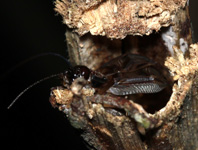Abstract
The egg, all three larval instars, and pupa are described for the cucujoid beetle species Monotoma (s. str.) testacea Motschulsky, which develops in decomposing plant matter. Adults and larvae were fed with baker’s yeast under laboratory conditions; this food source allowed for successful breeding of several generations. Detailed and illustrated descriptions of all immature stages are given. It is suggested that simple, pointed setae may represent a diagnostic character for Monotoma (s. str.), whereas clavate setae characterize Monotoma (Gyrocecis). Only minor differences in the number and patterns of setae were found between first, second and third larval instars, supporting observations of previous authors. Morphological differences are listed to distinguish between the three larval instars. An arrow-head aggregation of coarse asperities on the frontal region of the L1 larva, lacking in older instars, is hypothesized to be an egg-burster. Only 34–42 days elapsed from egg laying to emergence of the adult; the egg stage lasted 5–6 days; L1 larvae 2–3 days; L2 3–5 days; L3 2–5 days; the immovable prepupal stage 12–13 days; and the pupa 7–10 days. One female laid 1–5 eggs daily, averaging ~1.5 egg per day during her entire life; the total number of eggs in two independent cultures produced by one female accompanied by one male was 57 and 94.
References
Alarie, Y., Michat, M.C., Nilsson, A.N., Archangelsky, M. & Hendrich, L. (2020) Larval morphology of Rhantus Dejean, 1833 (Coleoptera: Dytiscidae: Colymbetinae): descriptions of 22 species and phylogenetic considerations. Zootaxa, 2317 (1), 1–102.
https://doi.org/10.11646/zootaxa.2317.1.1
Chandler, D.S. (1983) Larvae of wrack Coleoptera in the families Corylophidae. Rhizophagidae, and Lathridiidae. Psyche, 90, 287–296.
https://doi.org/10.1155/1983/36909
De Marzo, L. (2002) Larve di coleotteri in detriti vegetali di origine agricola: lineamenti morfologici e presenza stagionale (Polyphaga: 20 famiglie). Entomologica, Bari, 34, 65–131. [2000]
Eichelbaum, F. (1907) Die Larven von Cis festivus Panz. und von Emphylus glaber Gyll. Zeitschrift für wissenschaftliche Insektenbiologie, 3, 25–30.
Greco, N., Cluigt, N., Cline, A. & Liljesthröm, G. (2017) Life history traits and life table analysis of Lobiopa insularis (Coleoptera: Nitidulidae) fed on strawberry. PLoS ONE, 12 (7), e0180093.
https://doi.org/10.1371/journal.pone.0180093
Herbst, J.F.W. (1793) Der Käfer, fünfter Theil. In: Jablonsky, C.G. (Ed.), Natursystem aller bekannten in- und ausländischen Insekten. Vol. 5. J. Pauli, Berlin, pp. i–xvi + 1–392, pls. 44–59.
Jałoszyński, P. & Kilian, O. (2016) Description of the second- and third-instar larva of South African Stenomastigus longicornis (Boheman) (Coleoptera: Staphylinidae, Scydmaeninae). Zootaxa, 4158 (2), 151–182.
https://doi.org/10.11646/zootaxa.4158.2.1
James, D.G., & Vogele, B. (2003) Development and survivorship of Carpophilus hemipterus (L.), Carpophilus mutilatus Erichson and Carpophilus humeralis (F.) (Coleoptera: Nitidulidae) over a range of constant temperatures. Australian Journal of Entomology, 39, 180–184.
https://doi.org/10.1046/j.1440-6055.2000.00163.x
Klausnitzer, B. (1975) Zur Kenntnis der Larven von Myrmechixenus Chevrolat und Oxylaemus Erichson (Col., Colydiidae). Beiträge zur Entomologie, 25, 209–211.
Lawrence, J.F. (1991) Rhizophagidae (Cucujoidea) (including Monotomidae). In: Stehr, F.W. (Ed.), Immature Insects. Vol. 2. Kendall/Hunt Publishing Co., Dubuque, Iowa, pp. 460–462.
Motschulsky, V. (1845) Remarques sur la collection de coléoptères Russes de Victor de Motschulsky. Bulletin de Iα Société Imperiále des Naturalistes de Moscou, 18 (1–2), 3–127.
Okada, K. & Miyatake, T. (2007) Librodor japonicus (Coleoptera: Nitidulidae): life history, effect of temperature on development, and seasonal abundance. Applied Entomology and Zoology, 42 (3), 411–417.
https://doi.org/10.1303/aez.2007.411
Osborne, P. (1965) Morphology of the immature stages of Meligethes aeneus (F.) and M. viridescens (F.) (Coleoptera, Nitidulidae). Bulletin of Entomological Research, 55 (4), 747–759.
https://doi.org/10.1017/S0007485300049853
Peacock, E.R. (1977) Coleoptera Rhizophagidae. Handbooks for the Identification of British Insects. Vol. V. Part 5a. Royal Entomological Society of London, London, 19 pp.
Staniec, B., Zagaja, M., Pietrykowska-Tudruj, E. & Wagner, G.K. (2018) Comparative larval ultramorphology of some myrmecophilous Aleocharinae (Coleoptera, Staphylinidae), with a first description of the larvae of Amidobia talpa (Heer, 1841) and Oxypoda haemorrhoa (Mannerheim, 1830), associated with the Formica rufa species group. ZooKeys, 808, 93–114.
https://doi.org/10.3897/zookeys.808.29818
Wagner, G.K., Staniec, B., Zagaja, M. & Pietrykowska-Tudruj, E. (2020) First insight into detailed morphology of monotomids, with comments on chaetotaxy and life history based on myrmecophilous Monotoma angusticollis. Bulletin of Insectology, 73 (1), 11–27.


